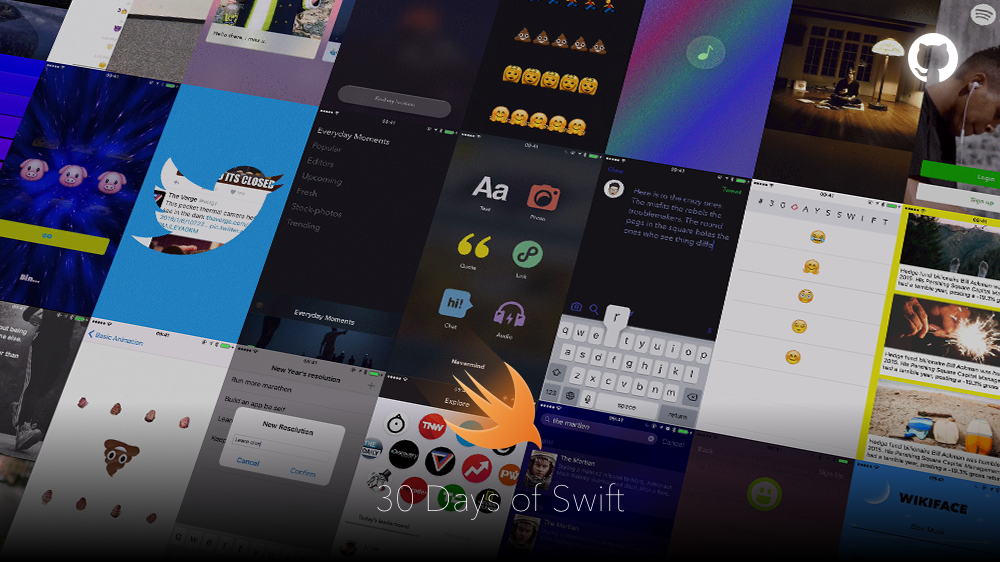Flow
This library provides a bunch of extension methods for a better fluent syntax in Swift. This style is very useful for some operations that benefit from being able to be chained (composed) together.
Functionality
-
.thento configure reference and value types. Useful for configuration at the point of initialization. -
.mutatein place value types. -
.letto transform an object into another. -
.doto perform multiple actions with the same object. -
Free function variants, for when you prefer this syntax or don't want to conform to the protocol:
with(similar to.then)withLet(similar to.let)
-
runas an alternative to immediately executed closures.
.then
Use .then to perform an object configuration inline. It applies statements in the closure to the object. It's very useful to set the properties of an object when defining it.
let label = UILabel().then {
$0.text = "Hello"
$0.textColor = .red
$0.font = .preferredFont(forTextStyle: .largeTitle)
$0.sizeToFit()
}
let size = CGSize().then {
$0.width = 20
}
There are two overloads of this method provided. One that works on
AnyObject(a.k.a. classes) and another that operates onAny(intended for value types). The compiler picks the correct one appropriately.
- In the closure you get a reference to
selfor aninoutcopy in case of value types. - It returns the same reference to the object, or the mutated copy for value types.
Influences:
.mutate
Mutates a value in place. It s like .then but applies to self instead of a new copy. The value needs to be defined as a var.
view.frame.mutate {
$0.origin.y = 200
$0.size.width = 300
}
- In the closure you get an
inoutreference toself. - It returns nothing.
This should be used only for value types. For reference types is recommended to use
.then.
.let
You can think of .let as a map operation but for all the types (not only for Functors). It lets you transform the object into an object of another type.
let dateString: String = Date().let {
let formatter = DateFormatter()
return formatter.string(from: $0)
}
It works especially well for type conversions based on initializers:
let number: Int? = "42".let(Int.init)
Don't overuse this when you can use just plain dot syntax. You can use it to access a member of the object
Date().let { $0.timeIntervalSince1970 }but that's just the same asDate().timeIntervalSince1970.
- You get a reference to
selfin the closure. - It returns the object returned in the closure.
Influences:
- Swift's own
letdeclaration. - Kotlin.let and Kotlin.run.
.do
Use this method to perform multiple actions (side effects) with the same object. It helps to reduce the verbosity of typing the same name multiple times.
UserDefaults.standard.do {
$0.set(42, forKey: "number")
$0.set("hello", forKey: "string")
$0.set(true, forKey: "bool")
}
This behaves like other methods if you discard their return, but is preferred to use do to convey the intention better. It also lets you avoid writing the return on some occasions.
- You get a reference to
selfin the closure. - It returns nothing.
Influences:
.debug
By default, it prints self to the console. This method is useful for debugging intermediate values of a chain of method calls.
let result = Object()
.then { ... }
.debug("prefix")
.let { ... }
.debug()
- You get a reference to
selfin the closure. - It returns the same object without touching it.
Free function with
Executes a closure with the object. This free function it's a substitute for .then when you can't use the method or if you prefer the free function style.
let label = with(UILabel()) {
$0.text = "Hello"
$0.textColor = .red
$0.font = .preferredFont(forTextStyle: .largeTitle)
$0.sizeToFit()
}
- You get a reference to an
inoutcopy ofselfin the closure. - It returns the returned object in the closure.
Influences:
- Overture.with
- Kotlin.with
- Many other languages have a
withorusingfunction.
Free function withLet
Variant of with that let's you return a different type. It's a free function alternative of let.
Free function run
Executes a closure of statements, useful to be used when you need an expression. This is like making a closure and invoking immediately but sometimes is clearer to have a specific name for it.
let result = run { ... } // same as { ... }()
Influences:
Supported Types
Since Swift doesn't let us extend non-nominal types like Any we need to conform each type to the Flowable protocol.
The library provides out of the box conformances for a bunch of Standard Library, Foundation and UIKit types. See Conformances.swift for the entire list.
You can conform any type yourself by just extending it:
extension YourType: Flowable {}
Note that you can use the free function variants without the types conforming to the protocol.
Influences
- devxoul/Then
- Functional style approaches (like Overture)
- Kotlin Scope Functions. Note that Swift can't "rebind self" inside a closure, so most of Kotlin's scope functions are redundant.
- Other languages that have a similar
withorusingfunctions.
Author
Alejandro Martinez | https://alejandromp.com | @alexito4



